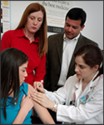 |
|
|
For
immunization safety information, call the CDC-INFO Contact Center at:
English and Spanish:
(800) CDC-INFO
(800) 232-4636
TTY: (888) 232-6348
Send mail to:
Vaccine Safety
|
 Get email updates
Get email updates |
 |
 |
 |
 |
Monitoring health problems after vaccination is
essential to ensure the United States continues to have the safest, most
effective vaccine supply in history.
CDC's Immunization Safety Office identifies
possible vaccine side effects and conducts studies to determine whether
a health problem is caused by a specific vaccine. |
In the News
 FDA Revises Gardasil Label:
FDA Revises Gardasil Label:
Healthcare providers are reminded to closely observe patients for 15 minutes following vaccination due to reports of fainting and falling.
 H1N1
Flu Update: H1N1
Flu Update: The outbreak of disease in people caused by a new influenza virus of swine
origin continues to grow in the United States and internationally.
CDC is issuing and updating interim guidance daily in response to the
rapidly evolving situation.
More...
Featured Items
|
 |

Health Topics
Government Agencies
Helpful Links
|
 H1N1
Flu Update: The outbreak of disease in people caused by a new influenza virus of swine
origin continues to grow in the United States and internationally.
CDC is issuing and updating interim guidance daily in response to the
rapidly evolving situation.
More...
H1N1
Flu Update: The outbreak of disease in people caused by a new influenza virus of swine
origin continues to grow in the United States and internationally.
CDC is issuing and updating interim guidance daily in response to the
rapidly evolving situation.
More...